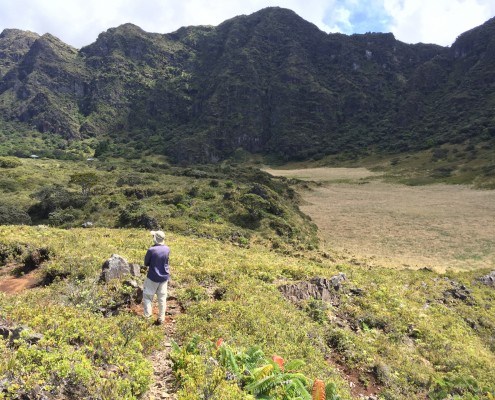
Hiking Haleakala
Haleakala National Park Summit Area Trailheads
There are some spectacular hiking trails throughout Haleakala’s summit area. However, only a handful of them are what most people would consider a “day hike”. This is because most of the Crater trails are backcountry wilderness with no roads and spotty cell phone service. A few even require overnight stays at the Park’s cabins or campsites. Only a small number of hiking visitors descend to the crater floor. Many more chose to go with a ranger or with a guide for day hikes into Haleakala crater and there are some interesting trails in the moderate to easy range at Hosmer Grove. There is also a campground which we will cover in the Camping in Haleakala section of this article.
Haleakala National Park Kipahulu Area Trailhead
Along the Road to Hana
Be prepared for hot, humid weather year round. The weather can change rapidly – bring sun and rain protection. Wear sturdy, closed-toed shoes on all trails. All trails are unpaved. Pets are not permitted on any trails.
Pīpīwai Trail
Take a hike up this 4-mile (round trip) trail that winds through a freshwater stream and diverse forest areas with views of waterfalls and other natural features. This trail is moderately strenuous with an 800-foot elevation change each way.
Pīpīwai Trail Guided Ranger Hike
The guided Pīpīwai Trail hike will now be on a reservation basis offered on Sundays at 10:00 am. Hikes cannot be booked until 9:00 am, one week prior to the hike. To reserve, please call 808-248-7375.
Kuloa Point Trail
This 1/2-mile (round trip) trail leaves the Kīpahulu Visitor Center and continues past a Hawaiian cultural demonstration area to the Kuloa Point at the mouth of ‘Ohe’o Gulch. This trail is easy with an 80-foot elevation change each way.
Kahakai Trail
This 1/2-mile trail extends from Kuloa Point to the Kīpahulu Campground passing by archaeological sites and gorgeous ocean views.
Swimming is not recommended in the Kīpahulu District of the park. Water quality varies and violent flash floods or rock falls can occur in the stream at any time. Injuries and deaths have occurred. Visitors should always comply with signs, heed the guidance of park staff, and stay out of closed areas. It can take an ambulance up to 45 minutes to arrive at Kīpahulu from the nearest town. You are responsible for your own safety.
- Diving and jumping are prohibited.
- Do not bring glass into the ‘Ohe’o Gulch area.
- Due to rough conditions, there is no safe ocean entry in Kīpahulu.
Haleakala National Park Campgrounds & Cabins
Being Prepared In The National Park
If you’re planning on hiking or camping within the crater there will be quite a bit of preparation and gear you will need depending on the amount of time of your stay. Below is a list of gear and preparations that the park services recommends for overnight camping in Haleakala crater’s wilderness areas and cabins:
The Wilderness Area is remote and experiences unpredictable weather. Temperatures vary from 40-70 degrees Fahrenheit during the day and 30-50 degrees Fahrenheit at night. Plan for rain at all times of year. If it is stormy, winds can exceed 80 miles per hour with temperatures dropping well below freezing.
Hiking trails may be steep. Terrain may include loose cinders and/or rocks. Change in altitude can be from a high of 9,780ft to a low of 6,380ft.
Allow for adequate travel time. Keep in mind that it can take twice as long going up the steeper trails as it does to hike down due to the altitude.
Packing List – Necessities:
– Trowel, toilet paper, zippered plastic bags (for carrying out toilet paper)
– Layered, warm clothing (avoid cotton)
– Full rain gear
– Hat, sunglasses, sunscreen/sunblock
– Water bottles (2 liters/person/day)
– Sturdy shoes, extra socks
– Hiking poles
– Water treatment supplies
– Bags for trash
– Sleeping bag
– First aid kit
– Flashlight or headlamp, extra batteries
– Portable lantern or dripless candles
– Kindling (newspaper, cardboard)
– Lighter or matches (preferably waterproof)
– Emergency contact phone numbers
Suggested Items For Your Packing List:
– Camera
– Slippers or camp shoes
– Toiletries
– Sponge or rag for cleaning
– Can opener
– Playing card, books
Haleakala Crater
At just over 10,000 ft elevation Haleakala (which in Hawaiian means “House of the Sun”) National Park is one of the top 5 things to do in Maui. It is one of the few places in the world where you can drive from sea level to 10,000 ft in less than 40 miles. The switchback road up the mountain is a spectacular drive. Drive carefully up this winding, hairpin turning road especially in the winter as it can get cold enough to snow and the wind can be vicious at the higher elevations. Winter months are also the Nene geese’s nesting season (the Nene is Hawaii’s state bird and a relative of the Canadian geese) so watch for them along the road above the Park Headquarters. This bird is just one of several native and non-native plants and animals you may encounter traveling up the slopes of Haleakala volcano.
Haleakala National Park overnight facilities include a drive in campground at Hosmer Grove which is pretty basic. One of the great things about camping at Hosmer Grove Campground is the park rangers do a night skywatching tour. It’s a short walk after sunset from the campground to an open field where everyone lays down on their backs and the rangers point out many constellations including the stars that guided the original Hawaiians to the islands from ancient Polynesia.
It was amazing to learn how far the Polynesians ventured into the pacific and it is speculated they may have gone as far as South America and the Northwest Coast of America. Very cool information.
The drive-in campground is located at around 6800 feet elevation near the Park Headquarters. This means the nights are chilly so bring a jacket, warm hat and even gloves if you plan on staying overnight. The parking lot at the summit is about a 20 minute drive and the stars, especially the milky way, shine incredibly bright at this altitude. If you’re into night photography be sure to bring extra batteries as the cold drains them fast.
The crater itself has two main trails down into it from the summit. Halemu’u trail is a steep switchback trail down a rocky cliff and the other, called Sliding Sands Trail, is longer but fairly smooth going. The parks service often does a full moon hike down the switchback trail which is an amazing night hike down and back.
Aside from these great day and night hikes you can also camp within the crater where there are several wilderness campgrounds with wilderness cabins available at each. The cabins are open all year and are available for use by advanced reservation lottery. The summer months are best for backpacking and camping inside the crater as winter storms can be so cold at this elevation that snow can appear at any time. There are a total of 3 cabins inside the crater and to reach these cabins you must hike a minimum of 4 miles to Holua or 10 miles to Paliku.
For an extended stay of several days it is possible to hike down sliding sands trail to the Paliku Cabin then the next day to the Holua Cabin and back out the next day up the switchback Halemau’u Trail to the parking lot. Each cabin is allocated to one party as a unit, with a capacity of up to 12 people per night. Unreal Hawaiʻi published a great article about a 3 day backpacking trip into the crater. You can read about that journey HERE.
Campers should have provisions and equipment appropriate for cold, wet weather. There are no open fires allowed in the Wilderness areas, so portable camp stoves and a fuel supply are recommended. These campgrounds require a permit, available at Park Headquarters between 8:00 am and 3:00 pm daily. There are no additional fees for these camping permits. Space at both campgrounds is limited, and no advance reservations are taken for wilderness camping.
So there you have it. Even though this is a lot of information, it’s really just the basics of where to hike within Haleakala National Park. Just remember to always be respectful of no trespassing signs (they’re there for good reasons you may not be aware of) and stay on the paths in the national park. Above all else, enjoy yourself and be safe!








